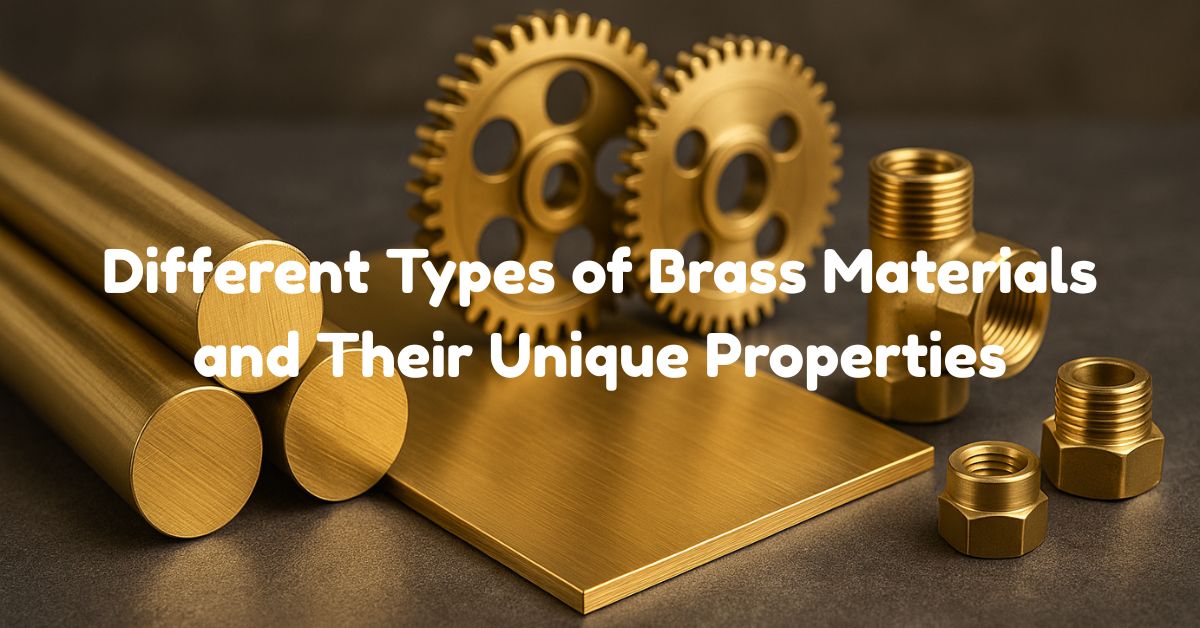Brass is one of the most widely used metal alloys worldwide. Its durability, resistance to rust, and eye-catching finish make it a favorite in countless industries. Brass is a mix of copper and zinc, and small amounts of other metals can change its qualities. Because of this, several types of brass material are available, each designed for different tasks, everything from beautiful decorative items to sturdy industrial parts. Knowing the differences between these brass types lets manufacturers, engineers, and buyers select the one that fits their needs perfectly.
In this blog, we’ll look at the main types of brass, what makes each one special, brass characteristics, and how brass is used in today’s industries.
What Is Brass Material?
Before we break down the types, it’s good to clarify what brass material is. Copper and zinc are the main alloys that make up brass. The exact mix of these metals affects the alloy’s strength, bendability, and how well it resists the elements. Small additions of metals such as lead, tin, or aluminum can enhance particular properties, making brass applications appropriate for a wide range of uses in many sectors.
Understanding the Composition and Characteristics of Brass
The metal composition of brass determines brass characteristics. When copper rises in the mixture, the alloy gains a warmer, golden finish and improved resistance to rust. More zinc, on the other hand, boosts strength and hardness. Brass is a popular material for plumbing, electrical systems, maritime equipment, and building because of its versatility.
Here are some key properties of brass:
- High malleability and ductility, allowing it to be easily shaped
- Good resistance to corrosion, especially in water and damp air
- Excellent thermal and electrical conductivity
- Attractive finish, making it popular for decorative uses
Major Types of Brass Material
Brass is available in several grades, but the following types of brass material are the most commonly found in industrial and commercial settings.
1. Alpha Brass
Alpha brass has over 65% copper and is valued for its cold-working ability. This brass type is frequently used for fasteners, hinges, and decorative fixtures since it can be shaped easily and resists corrosion well.
Brass usage example: Musical instruments, architectural fittings, and precision engineering components.
2. Alpha-Beta Brass (Duplex Brass)
This brass blend holds 55% to 65% copper and is easy to shape both hot and cold. Because it mixes alpha and beta phases, it delivers extra strength compared to alpha brass, making it perfect for parts that demand higher tensile strength.
Brass applications: Valves, gears, and marine hardware.
3. Naval Brass
Tin is added to naval brass to help it withstand corrosion in seawater. This extra protection is why it’s favored in shipbuilding and marine gear.
Brass usage: Propeller shafts, pump parts, and marine fasteners.
4. Cartridge Brass
With 70% copper and 30% zinc, cartridge brass is very ductile, which means it bends easily without breaking. Because of this, it’s the go-to choice for cold-formed ammo casings, earning it the nickname.
Brass characteristics: High strength, great corrosion resistance, and easy deep drawing.
5. Muntz Metal
Muntz metal runs about 60% copper and 40% zinc and comes at a lower price. It’s tough enough for big jobs and has decent corrosion resistance, so you’ll find it in places where weight and cost matter.
Brass applications: Ship sheathing, condenser tubes, and architectural panels.
Unique Brass Characteristics That Make It Valuable
Every types of brass material blend has unique traits, but a few general qualities keep it in constant demand:
- Corrosion Resistance: Amazing for marine and outdoor environments.
- Workability: Brass can be formed into intricate shapes without cracking.
- Aesthetic Appeal: Its rich gold hue makes it a favorite for decorative items.
- Durability: Brass maintains its integrity under high pressure and heat, making it reliable in industrial settings.
For high-precision parts, manufacturers like Brass Pin Manufacturers provide custom components that meet exact specifications every time.
Common Brass Applications Across Industries
Brass fits into a wide range of fields:
- Plumbing and Sanitation: Valves and fittings resist corrosion and have leak-proof joints.
- Electrical Components: Brass’s elasticity and conductivity make it perfect for connectors and terminals.
- Decorative Uses: We see it in door handles, picture frames, and artisan sculptures.
- Marine Equipment: Pumps, propellers, and fittings resist salty water.
- Automotive Industry: Brass heatsinks, gear wheels, and bearings stand up to heat and wear.
Brass Precision Parts companies handle exact tolerances, ensuring that every part can handle its job, no matter how tough.
Choosing the Right Brass Type for Your Needs
To pick the perfect types of brass material, think about:
- Environment: Will the part face water, chemicals, or extreme heat?
- Strength Requirements: Do you need a part that can flex without breaking or one that is hard?
- Aesthetic Requirements: Does the finished product’s color or finish matter?
- Cost Factors: Some brass alloys are cheaper in large quantities, which can lower overall costs.
Choosing high-quality Brass Terminals for any electrical project ensures consistent, long-lasting safety each time.
Sustainable Aspects of Brass Manufacturing
Brass is unique when it comes to sustainability. It may be regenerated repeatedly and returns stronger each time. Unlike some metals that lose strength after just one cycle, brass keeps its properties, making it a greener option. The World Brass Association reports that brass recycling rates are much higher than the rates for many other industrial metals, which means less raw metal needs mining, and less energy is used in production.
Conclusion
Brass is still a cornerstone alloy in both classic and cutting-edge industries. From alpha brass to corrosion-resistant naval brass, each types of brass material is engineered for its own set of challenges, whether you need seaworthy fittings, elegant decorative pieces, or ultra-precise industrial components. By learning brass characteristics and aligning them with your specific brass usage, you can confidently choose the best material. Partnering with a trusted supplier guarantees you’ll receive High-Quality Metal Components, longevity, and top-notch performance that every brass application demands.

